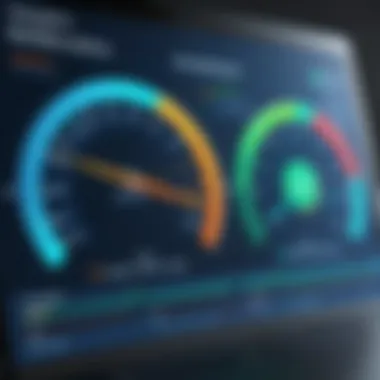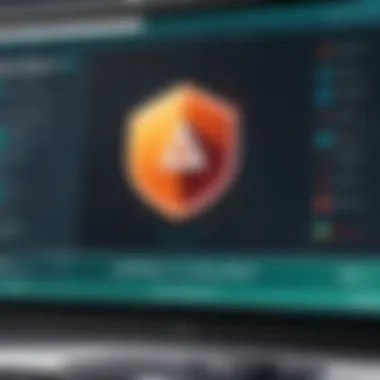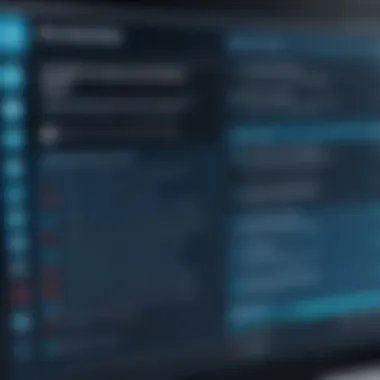Top Free Antivirus Solutions for Strong Malware Defense


Intro
In an age where digital threats are ubiquitous, robust cybersecurity has become a cornerstone of online safety. With many individuals and small businesses prioritizing protection against malware, the demand for effective antivirus solutions has surged. Many users turn to free antivirus options, seeking reliability without incurring costs. However, evaluating these free solutions can be complex due to the disparity in features, performance, and user experiences.
This article aims to provide a comprehensive analysis of free antivirus solutions specifically for malware protection. It highlights essential points, such as the strengths and weaknesses of various software options, critical evaluation criteria, and user experiences. Ultimately, the goal is to empower readers with informed insights to navigate the landscape of free antivirus software.
By understanding the nuances of these products, readers can select tools that are not only effective in safeguarding their systems but also meet their unique needs. From analyzing user feedback to comparing performance metrics, this evaluation will uncover what truly matters in the realm of free antivirus solutions.
Preface to Malware Protection
Malware protection remains a critical component in the realm of cybersecurity. As technology advances, so do the threats that aim to exploit vulnerabilities in computer systems. Understanding how malware operates is vital for anyone using electronic devices. This knowledge allows users to be proactive rather than reactive, helping to mitigate potential risks before they escalate into serious issues.
The digital landscape is fraught with various types of malware, including viruses, ransomware, spyware, and more. Each type poses unique threats and can inflict severe damage on both personal and professional data. Malware can corrupt files, steal sensitive information, or even render systems inoperable. Given the stakes, investing time in understanding malware and its protection is not only sensible but necessary.
With free antivirus solutions widely available, individuals have affordable options to protect their systems without heavy financial burden. Free antivirus software can offer robust capabilities including real-time scanning, web protection, and basic malware removal. Understanding which of these solutions best fits one's needs can make a significant difference. By evaluating factors like user interface, detection rates, and performance impact, users can select a solution that balances effectiveness and usability.
Moreover, the ongoing evolution of malware means that antivirus solutions must adapt continually. Regular updates and support become pivotal in ensuring that the software remains effective against new threats. One must consider these updates when evaluating free options, as some may lack adequate support compared to their paid counterparts.
In summary, the importance of malware protection extends beyond mere convenience. It is about safeguarding data integrity and maintaining operational capability in an increasingly digital world. As we delve deeper into the types of antivirus software and their respective strengths, it becomes evident that informed decision-making is key to achieving effective malware protection.
Understanding Antivirus Software
In the realm of cybersecurity, having a solid grasp of antivirus software is crucial. This understanding is not just about knowing how such software functions; it’s central to recognizing its role in safeguarding digital environments against potential threats. Malware, in its various forms, poses a significant risk to systems, data integrity, and the overall functionality of devices. Therefore, evaluating effective antivirus solutions becomes essential for users who wish to maintain their privacy, protect sensitive information, and prevent disruptions.
Definition and Purpose
Antivirus software is designed to detect, prevent, and remove malicious software from computers, networks, and devices. The primary purpose of antivirus is to safeguard systems against threats that can disrupt operations or compromise data. This protection is not limited to well-known viruses—it extends to various types of malware, including spyware, trojans, ransomware, and adware.
The functionality of antivirus software hinges on its ability to recognize patterns in code and behaviors that signify malicious intent. Most programs utilize a combination of signature-based detection and heuristic analysis to combat malware. Signature-based detection relies on a database of known malware signatures, while heuristic analysis allows the software to examine behavior and identify new, unknown threats. Thus, antivirus software serves as a first line of defense for individual users and organizations alike, constantly monitoring for threats that may attempt to infiltrate their systems.
Types of Malware
Understanding the types of malware is crucial for selecting the right antivirus software. Different malware types exhibit various behaviors, and recognizing these can enhance a user’s approach to cybersecurity. Here are some common types:
- Viruses: Programs that replicate and spread by attaching themselves to legitimate files. They can corrupt or delete data and often spread through infected downloads.
- Worms: Similar to viruses, worms can self-replicate. They do not require a host file and can exploit vulnerabilities in software or operating systems.
- Trojans: Malicious software disguised as legitimate applications. They can create backdoors for attackers to access and control infected systems.
- Ransomware: A particularly notorious type of malware that encrypts a user's files and demands payment for their release.
- Spyware: Programs that secretly monitor user activity and gather personal information without consent.
- Adware: Though often viewed as less malicious, this software displays unwanted advertisements and can affect system performance.
By understanding these types, users can better appreciate the necessity of effective antivirus software tailored to their needs. Evaluation of antivirus solutions involves considering how well they protect against these diverse forms of malware while ensuring minimal impact on system performance. The right solution fortifies the user’s defenses against the ever-evolving landscape of cyber threats.
Criteria for Selecting Free Antivirus Software
Selecting the right free antivirus software is a critical step in ensuring robust malware protection. This section aims to appreciate the foundational criteria that can guide a user to make an informed decision regarding antivirus solutions. The effectiveness of antivirus software not only depends on its core functionalities but also on its adaptability to individual user needs. Understanding these criteria is essential for navigating the diverse landscape of available options and optimizing security without making a financial investment.


Detection Rates
Detection rates are an essential metric when evaluating free antivirus programs. This measure indicates how efficiently the software identifies and neutralizes malware threats. High detection rates signify that the antivirus can catch a majority of malware types, including viruses, trojans, and ransomware. A user should look for products that regularly update their malware definitions and utilize cutting-edge detection technologies, such as heuristic analysis and behavior monitoring. Many industry analysts rate software on a percentile basis, so looking for programs with over 90% detection rates is a prudent strategy.
Performance Impact
Performance impact refers to how antivirus software affects system resources during its operation. Since genuine antivirus programs run in the background, it is essential that they do not significantly slow down the user’s system performance. Important aspects to consider include CPU usage, memory consumption, and the duration of scans. Ideally, a well-optimized antivirus will perform scans with minimal disturbance, allowing users to continue other tasks seamlessly. Testing the software in real-world scenarios often yields insights into its performance impact, thus making it easier to compare different options.
User Interface and Experience
User interface and experience play a crucial role in the effectiveness of antivirus software. A straightforward, intuitive layout enhances the usability of the program, allowing users to navigate its features with ease. This is particularly important for individuals who may not be tech-savvy. Evaluating how quickly users can perform common tasks, such as scanning for malware or updating virus definitions, is essential. Good user experience can also lead to more consistent usage, which in turn increases overall protection.
Support and Updates
Regular support and updates are vital components of effective antivirus solutions. Software providers should offer adequate customer support, including troubleshooting assistance and updates to improve software performance or address emerging threats. Some free antivirus solutions may lack dedicated technical support, which can lead to extended downtimes for users facing issues. Hence, identifying software that provides timely updates and reliable support channels—be it through forums, chat, or email—will contribute significantly to maintaining optimal security.
Top Free Antivirus Software Options
The selection of free antivirus software is a crucial aspect of creating a robust security environment against malware threats. As the digital landscape continues to evolve, the variety of options available can be overwhelming. Understanding the specific benefits and limitations of each choice helps users make informed decisions that suit their individual needs.
Free antivirus tools can offer essential protection without financial commitment. These solutions often include basic features to defend against common malware types, but their effectiveness may vary significantly. Analyzing the top free options helps identify which software aligns with user expectations and security requirements.
When evaluating these antivirus solutions, it’s important to consider factors such as detection rates, system impact, user experience, and update frequency. Each of the following software options represents a distinctive approach to malware protection. Unpacking their characteristics can lead to better choices when securing devices against potential threats.
Avast Free Antivirus
Avast Free Antivirus remains a popular choice for those seeking free and effective malware protection. The software provides a comprehensive range of features. It's known for its strong detection rates and real-time protection capabilities. The interface is user-friendly and suitable for both novice and experienced users.
Avast also offers additional tools, such as a password manager and a network scanner. These features enhance overall security without overwhelming the user. However, the free version does include ads promoting paid upgrades, which might not appeal to everyone.
AVG AntiVirus Free
AVG AntiVirus Free is another well-regarded solution worthy of mention. It delivers solid malware protection and includes a number of active security features. This software emphasizes anti-malware scanning and has a reputation for efficiently identifying potential threats. The straightforward user interface provides easy navigation, making it accessible for users of varying skill levels.
Moreover, AVG has a unique Email Shield feature. This ensures that email attachments are scanned for malware before they can cause harm. However, like some other free options, its updates and additional functions can be less frequent compared to premium alternatives.
Bitdefender Antivirus Free Edition
Bitdefender Antivirus Free Edition offers a minimalist approach to security while still providing top-notch detection rates. The interface is clean and focuses on essential features, emphasizing ease of use. Users appreciate its effective background protection and automatic updates, which keep the software up to date with the latest threat information.
A standout feature is the automatic scan that initiates at the installation. It helps users quickly identify any existing threats on their system. This simplicity, however, may lack the depth of customization seen in more complex software, which could be a drawback for advanced users.
Microsoft Defender Antivirus


Included for free with Windows operating systems, Microsoft Defender Antivirus has made significant improvements in recent years. It offers comprehensive protection against malware and integrates seamlessly into the Windows environment. Users benefit from continuous updates, backed by Microsoft's extensive threat intelligence.
With features such as Real-Time Protection, it actively monitors device activity. Some users find its functionalities sufficient for everyday use, especially those who prefer not to install third-party software. However, it may not always perform as strongly in independent tests compared to dedicated antivirus solutions.
Kaspersky Security Cloud Free
Kaspersky Security Cloud Free brings a strong reputation for malware detection to the table. It includes a variety of protective features such as a password manager and cloud-based security options. The user interface is known for being intuitive and visually appealing, which can add to user satisfaction.
Kaspersky emphasizes optimal protection without major system slowdowns, making it suitable for use on older machines as well. However, while it offers essential features for free, advanced functionalities may require a shift to a paid version, which could lead to considerations about cost over time.
Choosing the right free antivirus solution requires assessing your unique needs. Explore each software's hands-on experience before deciding.
Understanding these top free antivirus applications fosters better decision-making. Choosing the right free software can empower users to establish a secure computing environment without incurring costs.
Comparative Performance Assessment
Evaluating the performance of antivirus solutions is crucial when choosing the right free software for effective malware protection. Comparative performance assessment provides insights into how different antivirus programs handle security threats. It is essential to critically analyze detection rates and the impact on system resources to understand the efficacy and efficiency of these tools. Such assessments help users identify which software can safeguard their systems without significantly hindering their performance. This understanding is particularly important for technology enthusiasts who often utilize resource-intensive applications such as gaming or graphic design tools.
Detection Test Results
Detection test results are a key element in assessing the effectiveness of any antivirus program. They determine how well a software solution identifies and manages various types of malware. High detection rates indicate that an antivirus solution is reliable and effective. For instance, independent testing organizations like AV-Test and AV-Comparatives conduct regular evaluations of antivirus solutions, providing users with valuable performance metrics.
These tests often involve exposing software to known malware samples, measuring their response time, and assessing how many threats are detected. Users should pay attention to results that reflect real-time protection capabilities, as malware threats can evolve rapidly. Software that excels in these tests demonstrates a strong ability to protect against both established and emerging threats, helping to maintain the integrity of user data and systems.
Impact on System Resources
The impact on system resources is another crucial aspect of a comparative performance assessment. Even the most effective antivirus solution will be of little use if it considerably slows down the host system. Free antivirus solutions are often scrutinized for their resource demands during scans or real-time protection modes.
In order to evaluate how antivirus software performs on systems, key elements to consider include:
- CPU Usage: A high CPU usage during scans can lead to sluggishness, making it difficult for users to perform other tasks.
- Memory Consumption: Efficient antivirus software should not consume excessive RAM; otherwise, it may hinder multitasking capabilities.
- Disk Activity: Programs that excessively utilize disk access can noticeably slow down not just the antivirus but the entire system.
Finding the balance between effective malware detection and minimal resource consumption is essential for users who require a smooth and uninterrupted computing experience. Evaluating the results from performance tests helps users select solutions that align with their specific needs, reinforcing the importance of conducting thorough comparative assessments.
User Experiences and Reviews
User experiences and reviews are critical in assessing the practicality and effectiveness of free antivirus solutions. While technical specifications and detection rates are important, the real-world impact of an antivirus program is often best illustrated through the experiences of individual users. Evaluating user feedback helps to uncover the nuanced aspects of software performance that may not be evident through lab tests. Factors such as ease of installation, user interface design, and the quality of customer support can significantly influence a user's satisfaction.
When considering an antivirus solution, users often report on various elements:
- Ease of Use: A complex software interface can deter everyday users. Reviews typically highlight how intuitive the installation and operation processes are.
- Effectiveness: Real-world scenarios of how a specific antivirus solution handled malware attacks provide insight into its true effectiveness compared to advertised claims.
- Customer Support: User feedback often touches on how responsive and helpful a company’s customer service team is during issues.
- Regular Updates: Considerations about how frequently the software receives updates can influence opinions about its long-term reliability and protection against new threats.
By analyzing these user reviews, prospective customers can better align their needs with the strengths and weaknesses of different antivirus solutions.


Case Studies
Case studies offer in-depth illustrations of real-life applications of antivirus software. They provide concrete examples of how specific free solutions address various malware threats in different contexts. Here, we explore several case studies:
- Home User: A teenager used AVG AntiVirus Free while participating in online gaming. After downloading additional software, malware attacked her system. The case reveals how AVG successfully detected and quarantined the malware, and highlighted the importance of active scanning in real-time protection.
- Small Business: A local coffee shop relied on Microsoft Defender Antivirus for its point-of-sale systems. A review highlighted an instance where the software’s robust firewall blocked external attacks, demonstrating Defender's effectiveness in a professional environment.
- Remote Worker: An individual working from home tested Kaspersky Security Cloud Free. He experienced a ransomware attack while opening email attachments. The program’s swift response and recovery process illustrated the importance of proactive defense in daily tasks.
These case studies not only reflect the efficacy of various antivirus solutions but also shape our understanding of their user satisfaction.
Expert Opinions
Expert opinions often lend additional credibility to user experiences. IT professionals analyze antivirus software against multiple criteria, offering detailed insights into their performance, functionality, and user accessibility. Experts typically consider:
- Technical Analysis: Experts evaluate the detection mechanisms utilized by antivirus solutions, discussing both heuristic and signature-based detections, along with their respective advantages and drawbacks.
- Longevity and Reputation: Many experts will comment on the track record of specific software companies. Brands with a consistent history of effective malware protection often receive favorable evaluations.
- Future Trends: Experts share insights about emerging technologies and how these will shape antivirus solutions. For instance, the rise of cloud-based solutions reflects an evolution in malware defenses, allowing for real-time updates and machine learning capabilities.
"User experiences paired with expert opinions create a comprehensive understanding of an antivirus software’s effectiveness. It’s about merging data-driven assessments with real-life applications to enhance security strategies effectively.”
Through these multifaceted reviews and analyses, individuals are better prepared to choose the right free antivirus solution that fits their needs. By understanding both user and expert perspectives, readers can make informed decisions based on a wider pool of knowledge.
The Future of Free Antivirus Solutions
The landscape of cybersecurity is constantly evolving, and free antivirus solutions play a crucial role in this domain. Understanding the future of these tools is essential for anyone concerned with digital security. Antivirus software is not just about coding defense against known malware, but also about adapting to emerging threats. This section will explore the key areas that will impact free antivirus solutions in the coming years.
Emerging Threats
The prevalence of cyber threats is increasing in both sophistication and variety. New types of malware emerge almost daily, and this continues to challenge traditional antivirus measures. This section highlights several threats that free antivirus solutions must prepare for:
- Ransomware: This type of malware encrypts user data and demands payment for the decryption key. Free antivirus software must be equipped to not only detect ransomware but also protect against it in real time.
- Phishing Attacks: With more users falling prey to deceptive emails and websites, effective detection of phishing attempts is becoming a crucial feature for antivirus solutions.
- Advanced Persistent Threats (APTs): These threats involve long-term strategies aimed at stealing sensitive information. Free antivirus solutions need to enhance their capabilities to detect and neutralize APTs before they can inflict damage.
Addressing these emerging threats requires a proactive approach. As threats evolve, free antivirus solutions must too, implementing advanced detection algorithms, machine learning, and behavior analysis to ensure comprehensive protection.
Trends in Antivirus Technology
As the digital world continues to develop, several trends within antivirus technology are shaping the future of free antivirus solutions:
- Cloud-Based Solutions: Many software developers are moving towards cloud-based antivirus solutions, which offer continuous updates and real-time protection. This trend allows users to access updated threat databases immediately, significantly improving protection against new threats.
- Artificial Intelligence and Machine Learning: Using AI and machine learning can provide free antivirus solutions with improved analytical power. These technologies can analyze patterns of malware behavior and help identify new threats faster than traditional methods.
- User Centric Design: The interface of antivirus software is becoming more user-friendly. Many solutions are adopting simpler designs that enhance the user experience while maintaining effective protection mechanisms.
- Integration with Other Security Tools: Future free antivirus solutions are likely to integrate with firewalls, VPNs, and other security applications. This will provide users with a more cohesive security package without an additional cost.
Epilogue and Recommendations
In our exploration of free antivirus solutions, it becomes clear that rigorous evaluation is paramount. This article aims to inform readers about the complexities of selecting effective malware protection without financial commitment. With the increasing prevalence of cyber threats, understanding which tools offer real protection is essential. Evaluating such solutions involves various elements including efficacy, user experience, and ongoing support. These aspects can significantly impact the overall cybersecurity landscape for individuals and small businesses alike.
Best Practices for Users
When utilizing free antivirus solutions, adopting best practices enhances protection. Consider the following suggestions:
- Regular Updates: Always ensure the antivirus software is up to date. New malware and vulnerabilities emerge continually. Keeping software updated maximizes protection.
- Utilize Additional Tools: Free antivirus software can be beneficial, but consider using complementary tools such as anti-malware scanners. Tools like Malwarebytes can provide an extra layer of security.
- Educate Yourself: Stay informed about types of malware and common phishing tactics. Awareness can significantly reduce the risk of infection.
- Back Up Data: Regularly back up important data. This practice ensures that in the event of a malware attack, recovery is more straightforward.
- Monitor Your System’s Behavior: Be vigilant about unusual system activity. Sudden slowdowns or unexplained behaviors may indicate malware presence.
Final Thoughts on Free Solutions
Free antivirus software can be a reasonable alternative for users seeking basic protection. However, caution is advised. While many options provide adequate defenses against common threats, limitations exist in features and ongoing support compared to paid versions. The user must assess their specific needs and consider whether a free solution suffices or if an investment is warranted.



